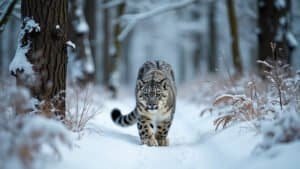Introduction
Snow leopards, known for their elusive nature and majestic presence in the rugged mountain ranges of Central and South Asia, have long fascinated researchers. To understand their evolution and adaptation to such harsh environments, scientists have turned to DNA analysis. By studying specific genetic markers, researchers can uncover the lineage, migration patterns, and genetic diversity of snow leopards
This article delves into the types of DNA markers used, the methods of collecting and preserving DNA samples, and how these analyses have helped trace the evolutionary journey of these remarkable big cats
Additionally, we will explore the challenges researchers face in this field and the advancements that have propelled snow leopard DNA research forward
DNA Markers Used in Snow Leopard Evolution Studies
Understanding snow leopard evolution through DNA analysis begins with the identification and examination of specific genetic markers. These markers are segments of DNA that can be used to trace lineage, assess genetic diversity, and reveal evolutionary adaptations
In snow leopards, researchers focus on various types of DNA markers, each providing unique insights into the species’ evolutionary history
Types of DNA Markers in Evolutionary Research
There are several types of DNA markers that researchers use in evolutionary studies of snow leopards
Microsatellites, also known as simple sequence repeats (SSRs), are one of the most commonly used markers. These are short, repetitive sequences of DNA that vary greatly among individuals, making them useful for studying genetic diversity and population structure
Another important type of marker is Single Nucleotide Polymorphisms (SNPs). SNPs are single base-pair variations in the DNA sequence that occur across the genome. They are valuable for understanding fine-scale genetic differences between populations and can reveal evolutionary changes that have occurred over time
In addition to these nuclear DNA markers, mitochondrial DNA (mtDNA) is often analyzed. Unlike nuclear DNA, which is inherited from both parents, mtDNA is maternally inherited. This makes it particularly useful for tracing maternal lineage and understanding the historical migrations and demographic changes in snow leopard populations
The mtDNA analysis has provided crucial insights into the matrilineal heritage of snow leopards, offering a window into the ancient movements and survival strategies of their ancestors
Significance of Mitochondrial DNA in Snow Leopards
Mitochondrial DNA plays a critical role in understanding snow leopard evolution because it offers a relatively straightforward method for tracing maternal ancestry
Given its high mutation rate, mtDNA can reveal genetic variations that accumulate over generations, making it a powerful tool for studying evolutionary relationships
For snow leopards, mtDNA studies have been instrumental in identifying distinct maternal lineages and in understanding how these lineages have dispersed across the species’ range
For instance, research has shown that snow leopards in different parts of their range, such as the Himalayas versus the Altai Mountains, have distinct mtDNA lineages, suggesting that these populations have been separated for extended periods
This genetic separation is likely due to historical geographic barriers that limited gene flow between populations, leading to divergent evolutionary paths
Genetic Diversity Insights from DNA Markers
Genetic diversity is a key factor in the survival and adaptability of any species. For snow leopards, DNA markers have revealed important aspects of their genetic diversity, which is crucial for conservation efforts
Studies using microsatellites and SNPs have shown that snow leopards have relatively low genetic diversity compared to other big cat species. This low diversity is a concern because it can make the species more vulnerable to environmental changes and diseases
However, the genetic data also highlight areas where conservation efforts can be focused. For example, identifying populations with particularly low genetic diversity allows for targeted conservation actions, such as habitat protection or the introduction of individuals from other populations to increase genetic diversity
These findings underscore the importance of genetic research in informing conservation strategies that aim to preserve the snow leopard’s evolutionary potential
Collecting and Preserving Snow Leopard DNA Samples
The process of collecting and preserving DNA samples is a crucial step in studying the evolution of snow leopards. Given the elusive nature of these big cats and the challenging environments they inhabit, obtaining high-quality DNA samples requires innovative techniques and meticulous care
Researchers must navigate the difficulties of remote fieldwork and ensure that the genetic material collected is viable for detailed analysis
Field Methods for DNA Sample Collection
Snow leopards are primarily found in rugged, high-altitude regions, making direct observation and sample collection extremely challenging
To overcome these obstacles, researchers often rely on non-invasive methods to gather DNA. One of the most common techniques involves collecting environmental DNA (eDNA), which includes biological material shed by snow leopards into their surroundings, such as hair, feces, urine, or skin cells
Scat collection is one of the most widely used methods for obtaining DNA from snow leopards. Researchers traverse the snow leopard’s habitat, searching for droppings, which are then carefully collected using sterilized tools to avoid contamination
Hair samples are another valuable source of DNA and are often collected from natural rubbing posts, where snow leopards leave behind fur as they mark their territory. Additionally, snow leopard tracks in the snow can sometimes contain cells that provide usable DNA
Another innovative method involves the use of camera traps combined with scent lures. These cameras not only capture images of the elusive cats but can also trigger the collection of hair samples when a snow leopard brushes against a strategically placed lure
This method helps link the DNA samples directly to the photographed individual, allowing researchers to correlate genetic data with specific animals
Challenges in DNA Preservation
Preserving the integrity of DNA samples collected in the field is a significant challenge due to the harsh environmental conditions where snow leopards live
The degradation of DNA can occur rapidly if samples are not properly handled and stored. Temperature extremes, exposure to sunlight, and moisture are some of the environmental factors that can compromise DNA quality
To mitigate these risks, researchers often use preservatives like ethanol or silica beads to stabilize the DNA in collected samples. For scat samples, which are particularly prone to degradation, immediate drying or freezing is recommended. In the field, portable coolers or dry ice may be used to preserve the samples until they can be transferred to a laboratory setting
Laboratories handling snow leopard DNA must follow strict protocols to prevent contamination and ensure the accuracy of the genetic analysis. This includes the use of sterile tools, controlled environments, and rigorous sample-tracking systems
Advances in preservation techniques, such as the development of specialized storage buffers, have improved the reliability of DNA samples, even when collected in remote and challenging locations
Innovations in DNA Extraction Techniques
The extraction of DNA from the collected samples is another critical step that can affect the quality and scope of genetic analysis
Snow leopard DNA extraction presents unique challenges, particularly when working with non-invasive samples like scat or hair, which often contain only small amounts of degraded DNA. Recent innovations in DNA extraction techniques have greatly enhanced the ability of researchers to retrieve high-quality genetic material from these difficult samples
One such advancement is the use of polymerase chain reaction (PCR) amplification techniques, which allow for the replication of small quantities of DNA, making it possible to perform comprehensive genetic analyses even from minimal amounts of material
Additionally, next-generation sequencing (NGS) technologies have revolutionized the field by enabling the analysis of complex genomes from even degraded DNA samples. NGS can sequence multiple regions of the genome simultaneously, providing a more detailed and accurate picture of the genetic makeup of snow leopards
These technological advancements have not only improved the efficiency and accuracy of DNA extraction but have also expanded the range of questions that researchers can address using genetic data
For example, they can now study the genetic health of snow leopard populations in greater detail, assess the impact of inbreeding, and explore the evolutionary relationships between different populations across the species’ range
Understanding Snow Leopard Lineage and Migration Through DNA
DNA analysis has become an indispensable tool for tracing the lineage and migration patterns of snow leopards
By examining genetic variations across different populations, researchers can reconstruct the evolutionary history of these elusive cats, revealing how they have adapted to diverse environments and how their populations have shifted over time
Tracing Lineage Using DNA Analysis
Tracing the lineage of snow leopards involves studying the genetic similarities and differences between individuals and populations. This process typically relies on the analysis of both mitochondrial DNA (mtDNA) and nuclear DNA markers
Since mtDNA is inherited maternally, it allows scientists to trace the maternal lineage of snow leopards over many generations. By comparing mtDNA sequences from snow leopards in different regions, researchers can identify distinct maternal lineages and estimate when these lineages diverged from one another
For example, studies have shown that snow leopards from the Himalayas and those from the Altai Mountains in Central Asia possess different mtDNA haplotypes, suggesting that these populations have been geographically and genetically isolated for thousands of years
Such findings provide valuable insights into how historical events, such as glaciation and the formation of natural barriers, have influenced the evolutionary trajectory of snow leopards
Nuclear DNA, which is inherited from both parents, provides a broader picture of snow leopard ancestry by allowing researchers to examine genetic contributions from both maternal and paternal lineages. This dual perspective helps in understanding the genetic structure of populations and how different populations are related to each other
It also sheds light on the extent of gene flow between populations, which is crucial for maintaining genetic diversity and resilience in the face of environmental changes
Migration Patterns Revealed by Genetic Data
Snow leopards are known for their wide-ranging movements across vast, often inhospitable terrains
However, understanding the historical migration patterns of snow leopards requires more than just observational data; it requires a deep dive into their genetic makeup. Genetic studies have revealed how snow leopard populations have migrated and adapted to various environments over millennia
For instance, genetic evidence suggests that snow leopards migrated from a common ancestral population into different mountain ranges, such as the Himalayas, Tien Shan, and the Tibetan Plateau, where they subsequently adapted to local conditions
The isolation of these populations in different mountain ranges has led to the development of distinct genetic characteristics, as gene flow between populations is limited by the challenging terrain
Moreover, genetic data can also reveal past events that have shaped current population distributions. For example, genetic bottlenecks—events where a significant portion of the population is wiped out, leaving only a small, genetically similar group to repopulate—can be identified through reduced genetic diversity in certain populations
This has been observed in snow leopard populations, where some regions show lower genetic diversity, likely due to past climatic events or human-induced habitat fragmentation that reduced their numbers and limited their range
Correlation Between DNA and Fossil Records
The correlation between DNA findings and fossil records provides a comprehensive understanding of snow leopard evolution
While DNA analysis offers insights into the genetic relationships and migration patterns of modern snow leopards, fossil records provide the physical evidence of their ancient ancestors and how they adapted to changing environments over time
By combining genetic data with fossil evidence, researchers can construct a more detailed evolutionary timeline for snow leopards. For example, fossils found in the Tibetan Plateau suggest that the ancestors of modern snow leopards may have lived in this region as far back as 3.5 million years ago
Genetic analysis supports this by indicating that the snow leopard lineage diverged from other big cats around the same time, adapting to the high-altitude environments of the region
The integration of DNA analysis with paleontological data allows scientists to trace the evolutionary history of snow leopards in response to environmental changes, such as the uplift of the Tibetan Plateau and the onset of glacial periods
These studies not only enhance our understanding of snow leopard evolution but also provide valuable information for conservation strategies, helping to protect these animals as their habitats continue to change
Challenges and Advancements in Snow Leopard DNA Research
Conducting DNA research on snow leopards is fraught with challenges due to the species’ elusive nature, the harsh environments they inhabit, and the technical difficulties involved in genetic analysis
However, recent advancements in technology and methodology have significantly improved the ability to study these big cats, leading to more accurate and comprehensive insights into their evolution and conservation needs
Common Challenges in Snow Leopard DNA Studies
One of the primary challenges in snow leopard DNA research is the difficulty in obtaining high-quality genetic samples. Snow leopards live in remote, mountainous regions that are often difficult to access, making direct observation and sample collection a daunting task
The scarcity of snow leopards in the wild further complicates this, as researchers may spend weeks or months in the field with little to show for their efforts
Additionally, the non-invasive samples commonly used in snow leopard studies, such as scat, hair, and environmental DNA (eDNA), often yield degraded or low-quantity DNA
These samples are prone to contamination from other species or environmental factors, which can complicate genetic analysis. The degradation of DNA in these samples also poses a significant challenge, as it limits the ability to retrieve complete genetic sequences
Another challenge is the lack of baseline genetic data for snow leopards. Compared to other big cats like lions or tigers, snow leopards have not been as extensively studied, resulting in a limited genetic reference database
This makes it difficult to compare genetic findings across different populations or to identify unique genetic traits within the species
Technological Advancements in DNA Analysis
Despite these challenges, technological advancements have greatly improved the feasibility and accuracy of snow leopard DNA research. One such advancement is the development of next-generation sequencing (NGS) technologies
NGS allows researchers to sequence entire genomes from even small or degraded DNA samples, providing a wealth of genetic information that was previously unattainable. This technology has been instrumental in identifying genetic variations between snow leopard populations and in uncovering the evolutionary history of the species
Another significant advancement is the use of environmental DNA (eDNA) analysis. eDNA involves the collection and analysis of DNA present in the environment, such as in water, soil, or air, rather than directly from the organism
This method has proven particularly useful for studying elusive species like snow leopards, as it allows researchers to detect their presence and gather genetic data without needing to physically capture or observe them
For instance, eDNA collected from snow leopard habitats can reveal the presence of the species, identify individual animals, and even provide information on the genetic diversity of local populations
The application of machine learning and bioinformatics tools has also revolutionized the analysis of genetic data. These tools can process vast amounts of genetic information quickly and accurately, identifying patterns and making connections that would be impossible through manual analysis
For snow leopard research, this means more detailed and precise insights into population structure, genetic diversity, and evolutionary history
Future Prospects for DNA Research in Snow Leopards
The future of snow leopard DNA research looks promising, with ongoing advancements in technology and methodology continuing to push the boundaries of what is possible
One area of potential growth is in the use of CRISPR technology, which could allow for precise editing of snow leopard DNA. While CRISPR is still in its early stages in wildlife research, it holds the potential to correct genetic defects, study gene function, and even enhance conservation efforts by increasing genetic diversity in small or isolated populations
Another exciting prospect is the use of long-read sequencing technologies, which can generate more complete and accurate genetic sequences than traditional short-read methods
This could provide a more comprehensive understanding of the snow leopard genome, uncovering previously hidden genetic variations and improving our knowledge of their evolutionary history
Collaborative efforts between conservation biologists, geneticists, and local communities are also likely to play a key role in the future of snow leopard research. By combining traditional ecological knowledge with cutting-edge genetic techniques, researchers can develop more effective conservation strategies that not only protect snow leopards but also ensure the survival of their ecosystems
As these advancements continue, they will undoubtedly lead to a deeper understanding of snow leopards and their place in the natural world, providing the tools needed to protect this iconic species for future generations
Conclusion
DNA analysis has become an essential tool in unraveling the evolutionary history of snow leopards, providing insights into their genetic diversity, lineage, and migration patterns. By studying specific DNA markers, researchers can trace the origins of different snow leopard populations and understand how they have adapted to various environments over millennia
The collection and preservation of DNA samples from these elusive cats present significant challenges, but advancements in genetic technology have greatly enhanced the ability to study them in detail
Innovations like next-generation sequencing and environmental DNA analysis have opened new doors in snow leopard research, offering more precise and comprehensive data than ever before. As these technologies continue to evolve, they will play a crucial role in shaping conservation efforts, ensuring that snow leopards remain a part of our planet’s biodiversity for generations to come













